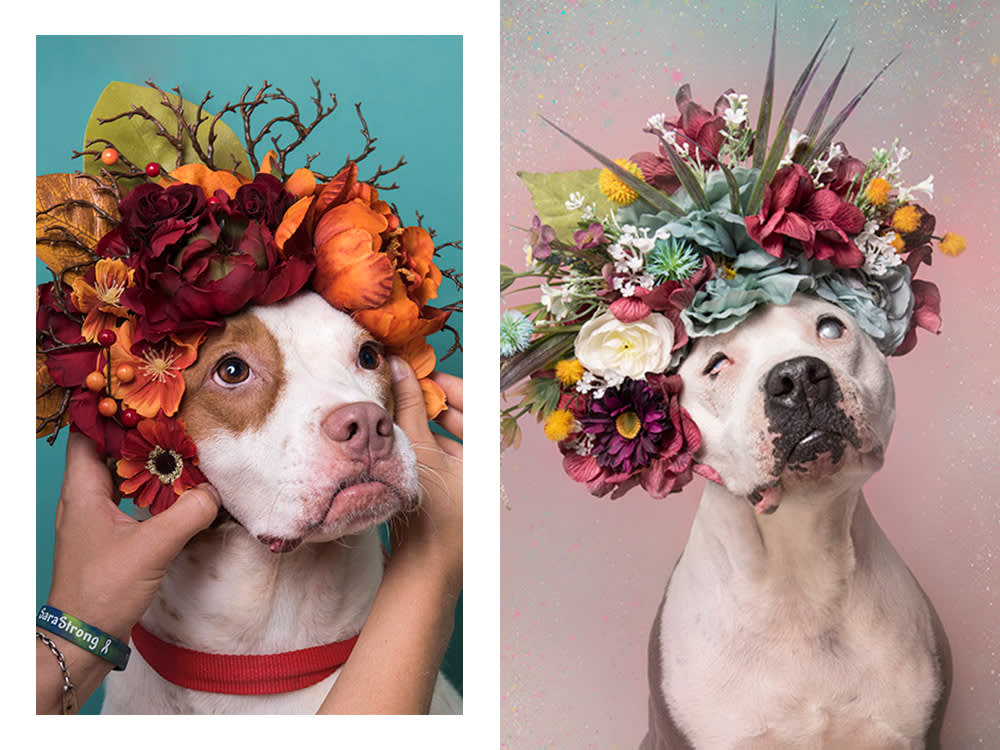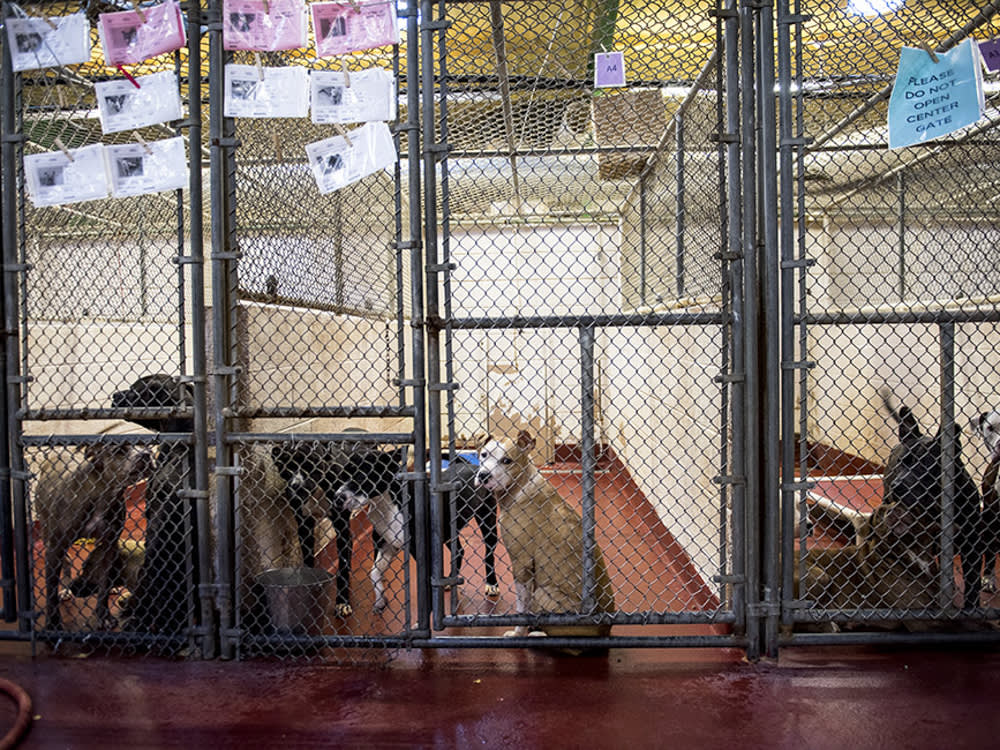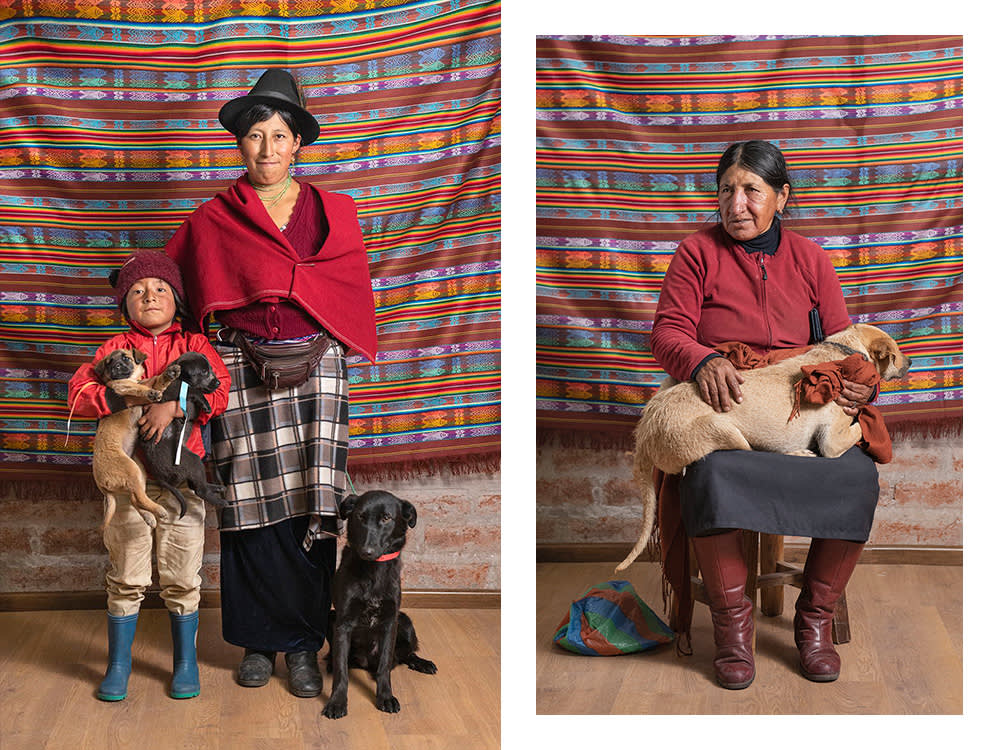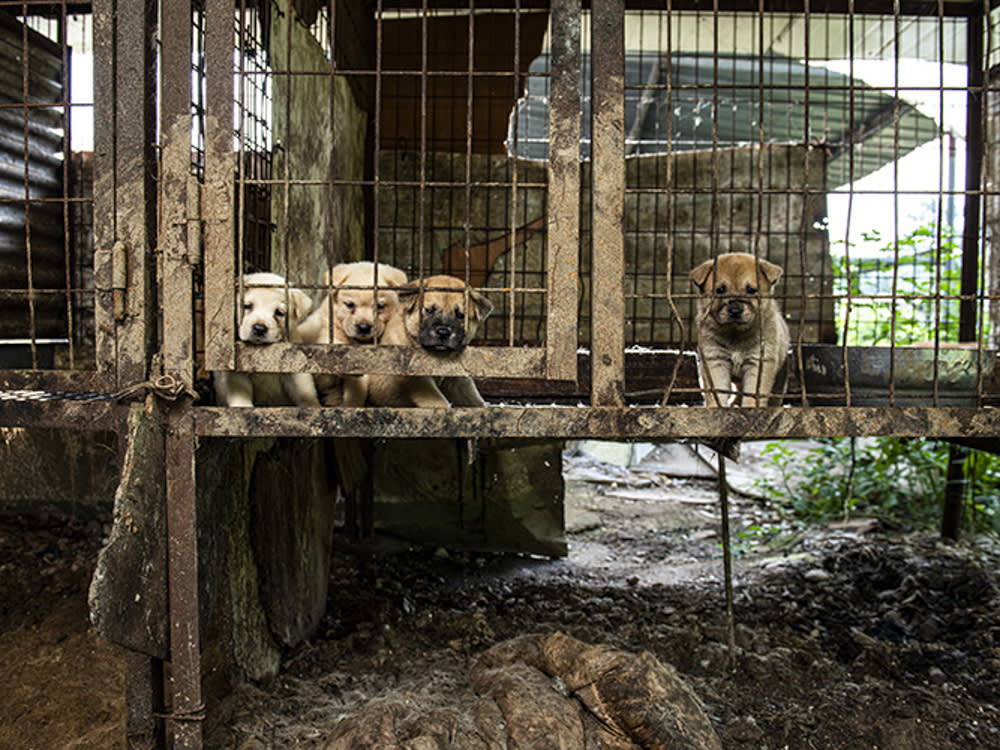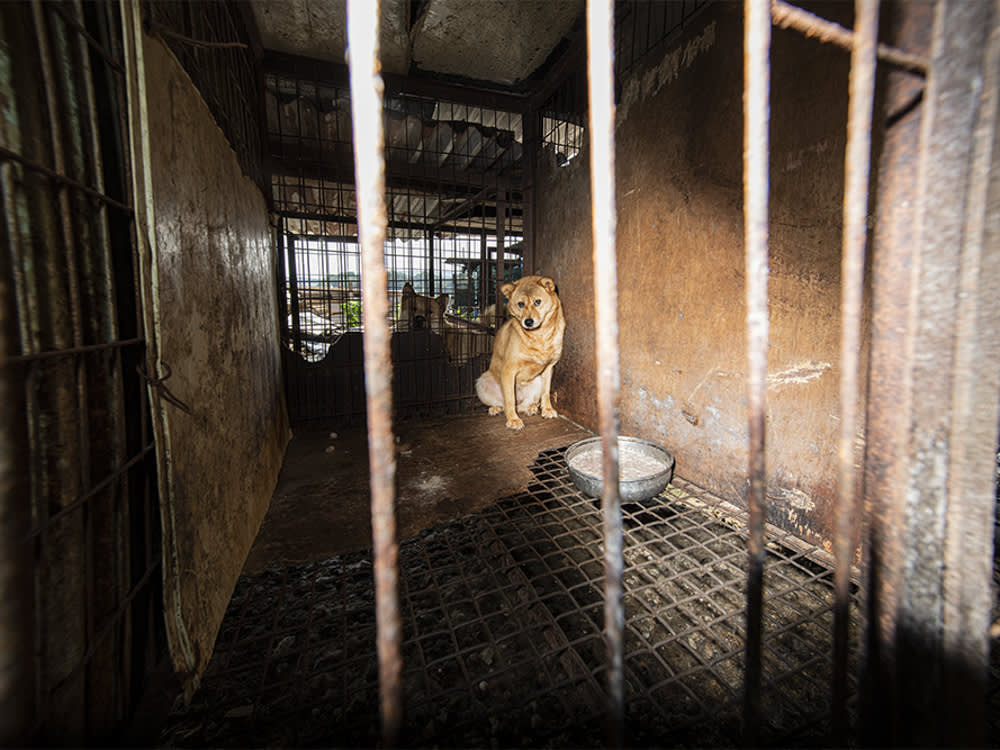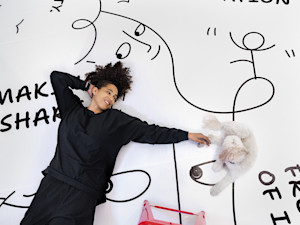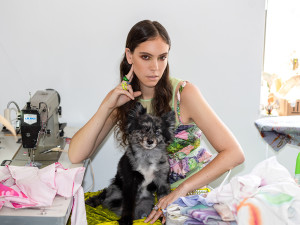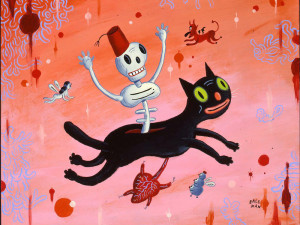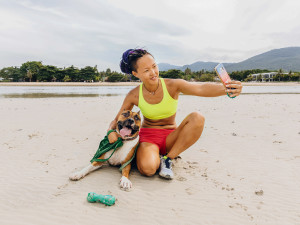How Sophie Gamand Showcases the Gentle Souls of Misunderstood Dogs
The artist and activist on how her work has helped hundreds of dogs get adopted (and how she copes with the heartache of photographing shelter and street dogs around the world).
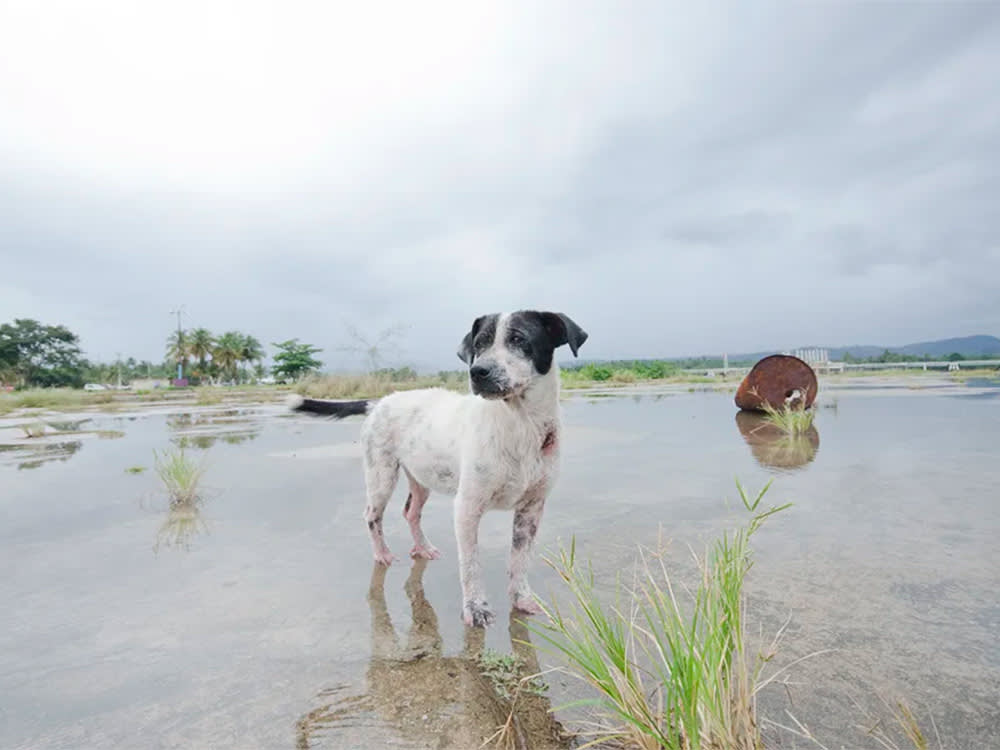
Share Article
You may not know Sophie Gamandopens in new tab by name, but you probably know her photos. The French-born, Los Angeles-dwelling artist is the creative force behind Pit Bull Flower Poweropens in new tab, the photo series (and book, calendar, and lots of other merch) that lovingly adorns the much-embattled breed with floral garlands. She’s also earned accolades for her gritty portraits of canines at a dog-meat farm opens in new tab in South Korea, as well as for her countless portraits of soulful shelter dogs.opens in new tab
And those are just a few of her projects since 2010, when she started photographing rescues — which is also how she met her dog, MacLovin, in Puerto Rico. Gamand is a photojournalist-activist, capturing a spectrum of emotional (some funny, some powerful), impossible-not-to-love canines.
All of this is even more impressive when you consider that Gamand started out as a prospective attorney (she has a master’s in law) and was an opera singer for a few years thereafter. She got into photography as a hobby, and animal rescue as a passion.
Kinship spoke with Gamand, currently at work on a multidisciplinary animal-themed exhibitopens in new tab, which opens tonight in LA and runs through Saturday, about her life’s mission.

You decided to capture Pit Bulls in your photos — while being quite fearful of them. How did you get over that?
I grew up in France, where they say, “Oh, the Pit Bull, that’s the dangerous dog.” There’s all this mythology around them. When I was about 12, I was mauled by a large dog, which was not a Pit Bull. I had a little bit of PTSD attached to that. In shelters, I would be confronted with Pit Bulls very often.
Pit Bull Flower Power was a way for me to get to know these dogs, let my guard down, and see what happens. What if I created an image of them that is so vastly different from what we’re used to? It forces us to reassess our perception. And it’s been a wonderful experience.
Was it tricky posing the dogs for Pit Bull Flower Power?
I always joke about when I realized I had to crown the dogs myself. How dumb was that idea? This is a dog that doesn’t know me. The first dog [I worked with], the whole experience really set the direction. She had been at the shelter for a while and was very sweet. Very family friendly, a great companion. But she didn’t show well in her kennel: She would hide in the corner. People didn’t connect with her.
She just sat there with the crown on her head and looked at me with such a calm energy. We both decided to trust each other. I have done over 450 portraits in that series, since 2014. Dogs who were rescued from dog-fighting rings. Those who just had surgery to remove a leg. Those who were super-scared. I did not immediately crown every dog I met — I always let them dictate the pace as much as possible.
I think of you as an activist, too, because you’ve inspired so many people to adopt Pitties.
The pictures got millions of views on social media. The shelters said they saw an uptick of people coming and saying, “Hey, I want to meet the dog in the photos.” The more it went viral, the more requests I got from shelters. I had a crazy wait list from all over the world.
I’m sure a lot of people also tried to commission you to photograph their dogs.
Private commissions, I found them really exhausting. I wanted to focus on homeless dogs, and I was busy! I never charged shelters. Everything was on my own dime — all the money I would make from selling calendars and stuff like that, I would reinvest in shelter shoots. I’ve met incredible networks of rescuers and shelters around the country.
Where have you traveled globally?
My first rescue experience was in Puerto Rico. I have never been on an island before! What I loved the most about my journey is how I had access to so many stories and paths of life. I’ve worked with a rescue in Mexico. I was in South Korea recently for my project with dogs who have been rescued from the dog-meat trade.
I was recently approached by a ton of people in Turkey, because they were facing a Pit Bull ban. And the president announced that all stray dogs had to be rounded up and put in shelters. A lot of dogs were massacred. I think, especially as a white rescue person coming from the U.S., going into another country and, “rescuing dogs” can be very problematic, so I try to be mindful of how I approach each global project.
What was it like photographing the dog-meat trade?
The reason I agreed to be involved is because I was approached by Humane Society International [HSI]. They work with local animal activists and organizations. They identify meat farmers who want out of the trade, looking for other options, but are stuck with hundreds or thousands of dogs.
So HSI comes in, and they basically sign legally binding contracts with those farmers who agree to never work with animals again and to transition to animal-free, more sustainable forms of businesses. The farms are shut down. All the dogs are rescued and rehabilitated, and sent to the U.K., the U.S., Canada to hopefully get adopted. I love the way they do it, because it’s about treating everybody involved with dignity.
We have to be extremely careful when we talk about this subject. There’s a really strong movement among South Koreans to end the dog-meat trade. Also, the way the dog-meat industry treats dogs is no worse than the way we treat pigs, cows, chickens, and other animals right here, right now. It’s no worse than the way we treat shelter dogs, which live in cages, sometimes for years, or how we euthanize them and throw their bodies in a trash bag like their lives meant nothing.
Tell me about your show, which opens in LA tonight.
I just relocated from New York to Los Angeles. And I took that opportunity to kind of take a breather, because I had been on the hamster wheel for so many years. That made me want to create more intentional work.
Of course, I’ll show some of my photography work, but I’m going to be showing some installations, maybe some paintings, embroideries, a couple of sculptures. I'm hoping to have a virtual-reality piece, which I’ve done before in partnership with my husband who works in VR.
I’m also making cyanotypes: You use reactive dyes on a piece of paper, and then you put a negative on it, and print that using sunlight. I’m using x-rays from shelters and rescues to create these really powerful visuals. All of these are going to be about our relationship with dogs. It will touch on consent, agency, and how gender dynamics permeate our relationship with dogs as well.
After all these years of being in very intense situations, how have you learned to cope?
I think I wear blinders a lot. When I’m in the moment, I try to not let my emotions overcome me. I find it very, very triggering to be in rows of kennels with other dogs barking at you. It’s very hard for me to be physically present. When I worked in Puerto Rico, I would be so tired for a couple of weeks after each trip and wondered why.
I came to realize over the years, “Oh, that was actually me dealing, absorbing everything I had witnessed and seen and all the heartache, and decompressing.” Being a photographer is almost like being a doctor: You focus on what’s in front of you, you deal with the emotions later I suppose.
Invisible Wounds of Friendship runs in L.A. from Oct. 6-8. On Saturday there is an artist reception from 5-9 p.m. and a dog adoption event from 5-7 p.m. 1443 W. Jefferson Blvd.

Nisha Gopalan
Nisha Gopalan has been a writer/editor for The New York Times, New York magazine, Entertainment Weekly, Variety, The Hollywood Reporter, and NYLON magazines. She currently resides in Los Angeles.
Related articles
![Artist, Shantell Martin laying on the floor with her dog in her studio.]()
Shantell Martin Is Stepping Boldly Into the Future (with Blanche at Her Heels)
The artist on penning a manifesto that empowers artists, choreographing a ballet, and how her dog fits into her creative process.
![Hillary Taymour with her small black dog]()
Hillary Taymour’s Pomeranian, Powwie, Is Hard at Work As the “Perfect Fashion Dog”
The Collina Strada designer’s pup is the ideal NYFW sidekick: He models, has great hair, and fits in a stylish bag.
![Painting of skeleton riding cat with heart below]()
Artist Gary Baseman on Late Cat Blackie & New Kitten Bosko
“Blackie was a friend and a collaborator. I never saw him as a pet and I don’t see Bosko as one either — they are family members.”
![Sophie Gamand with artwork collage]()
Sophie Gamand’s MacLovin-Inspired Holiday Gift Picks
A few of the artist and her rescue pup’s favorite things, from custom jewelry to DIY holiday ornaments.
![Woman Taking A Selfie With Her Dog Outside]()
How to Photograph Your Pet Like a Pro
The world needs cute pet pics. Here are five tips to help you go from amateur to Annie Leibovitz.

